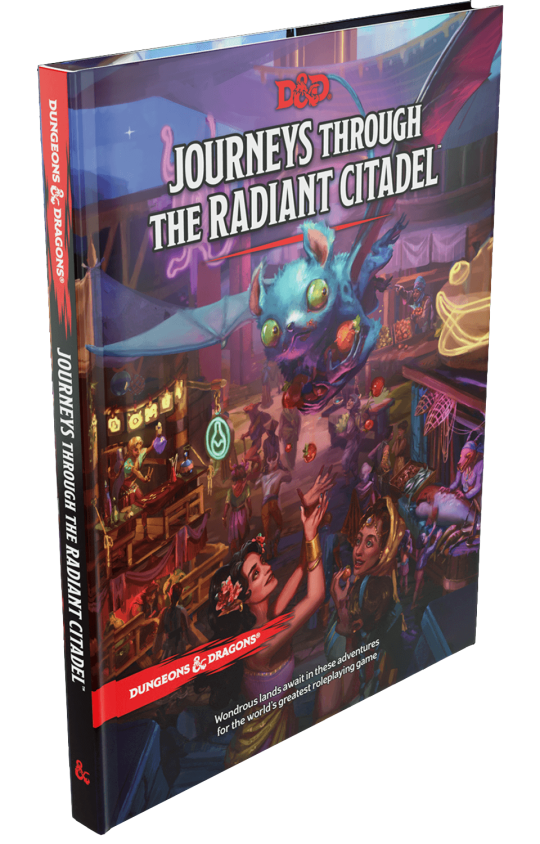Published scenarios often teach us that scenario hooks are a bang-bang interaction: The mysterious stranger in the corner of the tavern tells us about a mysterious artifact, hires us to go look for it, and we immediately head to the dungeon to retrieve it.
Or we’re traveling along an idyllic country road when we come across the smoking remnants of a merchant’s wagon that was attacked by goblins. The ranger finds their tracks and leads us back to their warren.
There’s nothing wrong with these bang-bang hooks. But they’re disproportionately represented in published adventures because the writers have no way of knowing what’s been happening in your campaign: Everything you need to run and play the adventure has to be self-contained in the adventure.
But as the GM, you do know what’s been going on in your campaign. In fact, you can control it. That gives you the power to easily do so much better than the author of that published scenario.
- What if, instead of a “mysterious stranger,” it’s a long-time ally or patron of the PCs? Someone they’ve built a relationship with.
- What if instead of fetching an artifact that an NPC wants, the McGuffin is something that the PCs need to accomplish their goals? Maybe the stranger isn’t buying their services, but selling them information.
- Instead of a random merchant, what if the goblins attacked someone the PCs know and care about?
- What if the goblins don’t just materialize out of thin air, but are a threat people in the local village have been talking about for weeks? Or are part of a goblin clan that the PCs have fought before?
These kinds of long-term threads will weave the adventure into your campaign. The stakes will be higher, and more meaningful to the players, because they aren’t just transitory concerns.
Long-term scenario hooks can be implemented in a variety of ways (and have a variety of effects) depending on the campaign structure you’re using, but for the sake of simplicity let’s focus on episodic campaigns for the moment — the players are presented with a single scenario; they complete the scenario; then they get presented with the next scenario.
Broadly speaking, there are two ways to implement long-term scenario hooks. First, you can retrofit the hook. When you pick or design your next adventure, you simply look back at the campaign to date and figure out how to use the existing continuity to hook the new adventure. What are the PCs trying to accomplish? What do they want? Who do they care about? Who do they hate? What are your players talking about between sessions? Just dangle it on the hook.
The other option is to plan for the hook. Which is basically what it says on the tin: If you know what adventures you’re planning to run later in the campaign, take a peek at them and think about how you can incorporate and foreshadow those elements into the earlier adventures of the campaign.
EXAMPLE: JOURNEYS THROUGH THE RADIANT CITADEL
SPOILER WARNING
As an example of what this prep might look like, let’s take a peek at Journeys Through the Radiant Citadel. This adventure anthology, shepherded into existence by project leads Ajit A. George and F. Wesley Schneider, is a collection of thirteen D&D 5th Edition adventures designed for PCs from 1st level through 14th level. Although loosely bound by the conceit that the adventures are set  in a location which can be reached via the transplanar nexus of the Radiant Citadel, each adventure is a completely standalone experience.
in a location which can be reached via the transplanar nexus of the Radiant Citadel, each adventure is a completely standalone experience.
Nevertheless, it seems quite likely that many DMs will run Journeys Through the Radiant Citadel as an episodic campaign, running each adventure in sequence, one after the other.
So how could we prep long-term scenario hooks for these adventures?
To start with, the tiers of play in D&D 5th Edition make for a handy rule of thumb here: To set yourself up for success, you should be dropping the groundwork for your Tier 2 and Tier 3 adventures in the Tier 1 adventures of your campaign.
The Tier 1 adventures in Journeys Through the Radiant Citadel are:
- Salted Legacy, in which the PCs get caught up in family drama and business rivalry in the Dyn Singh Night Market.
- Written in Blood, in which the PCs journey to a farming commune to uncover the source of an undead curse.
- The Fiend of Hollow Mine, in which the PCs must hunt down a demon-spawn which has unleashed a plague in San Citlán.
Using these scenarios as the foundation for our campaign, let’s take a look a the scenario hooks for the next several adventures in the anthology. One of the great things about Journeys Through the Radiant Citadel is that the designers have included multiple scenario hooks for each scenario, so we’ll have some nice flexibility in what we can work with.
Wages of Sin includes this scenario hook:
Zinda’s March of Vice is famous throughout the region. An influential ally of the characters requests that they attend and, while they’re there, purchase a bottle of jeli wine to be used as a gift in a diplomatic negotiation.
Let’s go back to “Salted Legacy.” The ally requesting the jeli wine purchase could actually be Lamai Tyenmo, the owner of Tyenmo Noodles who hired the PCs. But let’s also find ways of pointing forward: At the end of “Salted Legacy,” perhaps Tyenmo asks the PCs to keep their eyes open for interesting ingredients and drinks that she might use to create new noodle dishes and enhance her menu. (That’s a nice, open-ended link, because it’s quite likely the players will find ways to continue engaging with it in every adventure. “Hmm… I wonder aurumvorax steak noodles would taste like?”)
In “Wages of Sin,” the PCs get involved with Madame Samira Arah, a King of Coin (one of the rulers of Zinda), and her investigation into a series of attempted political assassinations. It might be nice to pre-establish her. If we reach back to “Written in Blood,” one of the hooks is:
A trader the characters have had past dealings with — perhaps from the Radiant Citadel or the Dyn Singh Market — invites the characters to Promise to participate in a business deal with Aunt Dellie.
We’ll have this merchant be Samira Arah. She’s been doing some economic outreach and the guards she had with her took ill after their visit to San Citlán. One of the merchants from “Salted Legacy” recommended the PCs to her, and she contacts them in the Radiant Citadel.
Sins of Our Elders takes place in Yeonido during the week-long Dan-Nal Festival. One of the hooks involves the PCs being invited to attend the festival by a family member or friend. You can look to the PCs’ backgrounds for the family member or friend (who might be native to Yeonido or might just want to visit), but we can add a little foreshadowing by having Samira Arah mention in “Written in Blood” that her next festival envoy will be to Yeonido.
Gold for Fools and Princes takes place in the Sensa Empire, where the empire’s rich gold mines are disrupted by an infestation of gold-eating aurumvoraxii. The big thing we’d really like to pre-establish here is the Empire’s reputation for goldsmithing and the powerful Aurum Guild. This should be fairly easy: Lady Drew, the trader from “Written in Blood,” can try to sell the PCs Sensan gold. In “The Fiend of Hollow Mine,” some of the miners who worked in the now-abandoned mine can talk about traveling to Sensa to see if they can find work with the Aurum Guild.
Trail of Destruction brings the PCs to Etizalan, where an increase in volcanic activity is threatening settlements across the region.
The Shieldbearers of the Radiant Citadel [think fantasy UN Peacekeepers] hire the characters to visit Tletepec to verify rumors that the region is becoming dangerous, so that they can prepare for an influx of refugees. They suggest the PCs start their investigations near Etizalan.
Here we want to pre-establish the Shieldbearers. We can do that by having them question the PCs after end the regional plague in “The Fiend of Hollow Mine.” We could also add a small squad of Shieldbearers active in the region — trying to bring aid to the plague victims — that the PCs could encounter earlier in the adventure.
And that’s more or less all there is to it. Obviously, you could also continue weaving these threads through the later adventures. For example, if the PCs are getting on well with Samira Arah, she might send them to the Goldwarrens on some errand as the primary scenario hook for “Gold for Fools and Princes.”
FOR THE DESIGNERS
Although I opened this discussion by saying that published adventures were predisposed to bang-bang hooks and that it’s impossible for adventure writers to know the continuity of the campaigns of the GMs who choose to run the adventure, it’s NOT true that you can’t design long-term scenario hooks for published adventures.
The trick is to simply prep tools and content that GMs can use before your adventure begins.
A tool I’ve developed in my work as a designer are groundwork sidebars. (These are one of several scenario tools you can used in published adventures.) Groundwork sidebars give the GM examples of how material can be incorporated into earlier adventures; it’s literally laying the groundwork for the adventure.
You can find numerous examples of this in the Welcome to the Island adventure anthology for Over the Edge, for example.
WATCH THIS
Advanced Gamemastery: The Campaign Stitch













Thanks for this thoughtful article! I’ve noticed published adventures assume the DM is wondering ‘I have a bunch of random people coming over to play D&D tonight how do I convince them to play this adventure.’
But that’s not how I use published adventures at all as a DM.
For me what I’m wondering is more along the lines of, ‘The players in my ongoing campaign are going into the next valley and I need some help prepping some interesting things that will allow them to continue their ongoing adventures.’
So I’d like adventure hooks that talk about how to integrate the adventure into the larger narrative like:
– if the players are looking for clues they will be found in rooms XYZ
– if the players are looking for a Macguffin it’s found in rooms XYZ
– your idea above of ‘if the players have a mentor they tell them XYZ’
– or even ‘here’s how to swap the big bad out for your big bad’
– connecting hooks to player backgrounds is cool
Thanks for a helpful article!